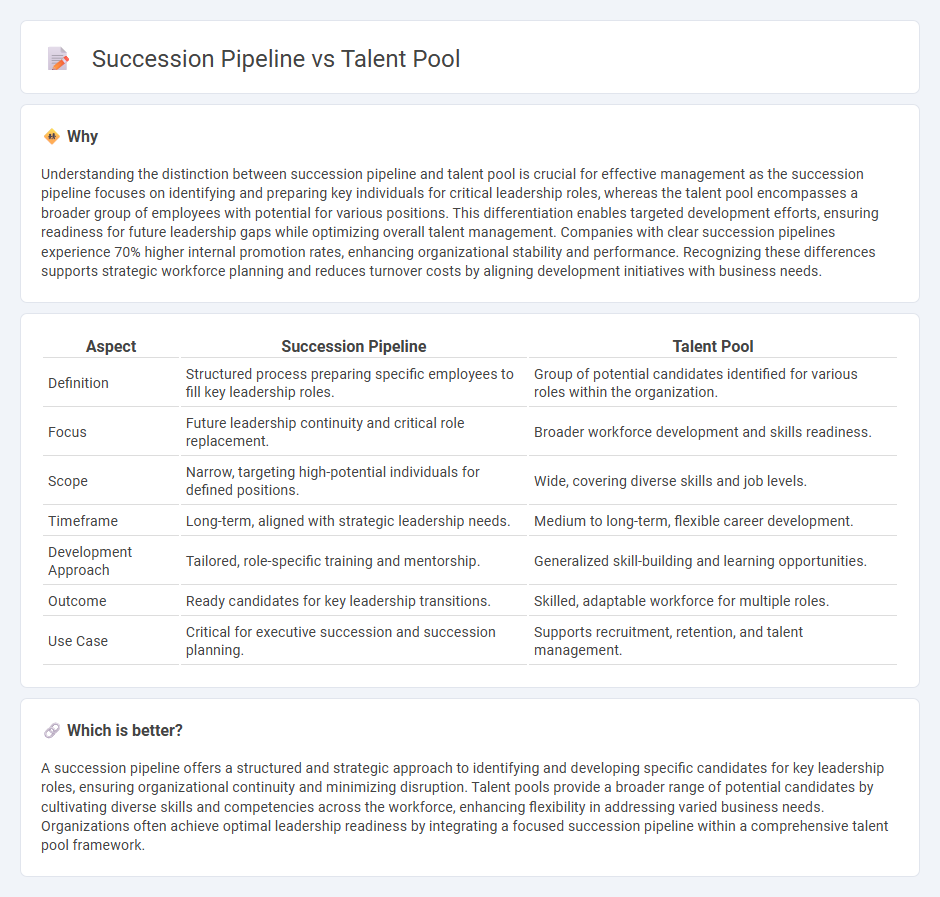
Succession pipeline focuses on identifying and preparing specific candidates for key leadership roles to ensure seamless transitions within an organization. Talent pool encompasses a broader group of employees with potential for various future positions, fostering overall workforce development and organizational agility. Explore how these strategic approaches optimize leadership continuity and talent management for your business.
Why it is important
Understanding the distinction between succession pipeline and talent pool is crucial for effective management as the succession pipeline focuses on identifying and preparing key individuals for critical leadership roles, whereas the talent pool encompasses a broader group of employees with potential for various positions. This differentiation enables targeted development efforts, ensuring readiness for future leadership gaps while optimizing overall talent management. Companies with clear succession pipelines experience 70% higher internal promotion rates, enhancing organizational stability and performance. Recognizing these differences supports strategic workforce planning and reduces turnover costs by aligning development initiatives with business needs.
Comparison Table
| Aspect | Succession Pipeline | Talent Pool |
|---|---|---|
| Definition | Structured process preparing specific employees to fill key leadership roles. | Group of potential candidates identified for various roles within the organization. |
| Focus | Future leadership continuity and critical role replacement. | Broader workforce development and skills readiness. |
| Scope | Narrow, targeting high-potential individuals for defined positions. | Wide, covering diverse skills and job levels. |
| Timeframe | Long-term, aligned with strategic leadership needs. | Medium to long-term, flexible career development. |
| Development Approach | Tailored, role-specific training and mentorship. | Generalized skill-building and learning opportunities. |
| Outcome | Ready candidates for key leadership transitions. | Skilled, adaptable workforce for multiple roles. |
| Use Case | Critical for executive succession and succession planning. | Supports recruitment, retention, and talent management. |
Which is better?
A succession pipeline offers a structured and strategic approach to identifying and developing specific candidates for key leadership roles, ensuring organizational continuity and minimizing disruption. Talent pools provide a broader range of potential candidates by cultivating diverse skills and competencies across the workforce, enhancing flexibility in addressing varied business needs. Organizations often achieve optimal leadership readiness by integrating a focused succession pipeline within a comprehensive talent pool framework.
Connection
A robust succession pipeline relies on a well-developed talent pool to ensure leadership continuity and organizational stability. Identifying high-potential employees within the talent pool facilitates targeted development programs, preparing candidates to step into key roles seamlessly. This strategic alignment enhances workforce agility and supports long-term business success.
Key Terms
Recruitment
The talent pool encompasses a broad group of potential candidates identified for various roles, while the succession pipeline specifically targets internal employees prepared for key leadership positions. Recruitment strategies for talent pools prioritize diversity and volume, whereas succession pipeline efforts emphasize skills development and leadership readiness. Explore more about optimizing recruitment to balance talent acquisition with future leadership needs.
Leadership Development
A talent pool consists of potential candidates identified for various roles across an organization, emphasizing broad leadership development and readiness. A succession pipeline specifically targets high-potential leaders earmarked for critical executive positions, ensuring focused skill-building and strategic grooming. Explore how integrating talent pools with succession pipelines accelerates leadership effectiveness and organizational resilience.
Workforce Planning
Talent pool refers to a broad group of potential candidates with the necessary skills and qualifications for future roles, while succession pipeline emphasizes a structured, prioritized progression of high-potential employees ready to fill key positions. Effective workforce planning integrates both concepts to align organizational growth with workforce capabilities, ensuring a steady flow of talent for critical roles. Discover how strategic workforce planning enhances talent management and succession readiness.
Source and External Links
Talent pool: What is it and how do you build a strong one? - This article explains what a talent pool is and provides strategies for building and maintaining it, emphasizing key skills, internal and external candidates, and employer branding.
What Is Talent Pooling? - This guide offers a step-by-step approach to developing a talent pool, focusing on aligning with organizational goals, assessing existing talent, and establishing training procedures.
What is a Talent Pool? Step-By-Step Guide to How to Build One - This article provides a six-step process for building a talent pool, including looking at previous applicants, keeping up with former employees, and fostering internal candidates.
 dowidth.com
dowidth.com